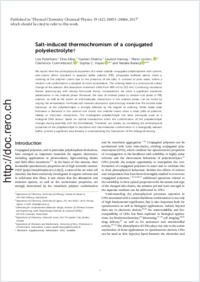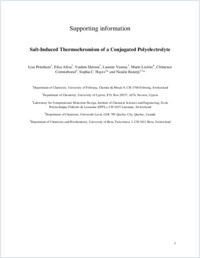Salt-induced thermochromism of a conjugated polyelectrolyte
- Peterhans, Lisa Department of Chemistry, University of Fribourg, Switzerland
- Alloa, Elisa Department of Chemistry, University of Cyprus, Nicosia, Cyprus
- Sheima, Yauhen Department of Chemistry, University of Fribourg, Switzerland
- Vannay, Laurent Institute of Chemical Sciences and Engineering, Ecole Polytechnique Fédérale de Lausanne, Switzerland
- Leclerc, Mario Department of Chemistry, Université Laval, Quebec , Canada
- Corminboeuf, Clémence Institute of Chemical Sciences and Engineering, Ecole Polytechnique Fédérale de Lausanne, Switzerland
- Hayes, Sophia C. Department of Chemistry, University of Cyprus, Nicosia, Cyprus
- Banerji, Natalie Department of Chemistry, University of Fribourg, Switzerland - Department of Chemistry and Biochemistry, University of Bern, Switzerland
-
01.11.2017
Published in:
- Physical Chemistry Chemical Physics. - 2017, vol. 19, no. 42, p. 28853–28866
English
We report here the photophysical properties of a water-soluble conjugated polythiophene with cationic side-chains. When dissolved in aqueous buffer solution (PBS, phosphate buffered saline), there is ordering of the polymer chains due to the presence of the salts, in contrast to pure water, where a random-coil conformation is adopted at room temperature. The ordering leads to a pronounced colour change of the solution (the absorption maximum shifts from 400 nm to 525 nm). Combining resonance Raman spectroscopy with density functional theory computations, we show a significant backbone planarization in the ordered phase. Moreover, the ratio of ordered phase to random-coil phase in PBS solution, as well as the extent of intermolecular interactions in the ordered phase, can be tuned by varying the temperature. Femtosecond transient absorption spectroscopy reveals that the excited- state behaviour of the polyelectrolyte is strongly affected by the degree of ordering. While triplet state formation is favoured in the random-coil chains, the ordered chains show a weak yield of polarons, related to interchain interactions. The investigated polyelectrolyte has been previously used as a biological DNA sensor, based on optical transduction when the conformation of the polyelectrolyte changes during assembly with the biomolecule. Therefore, our results, by correlating the photophysical properties of the polyelectrolyte to backbone and intermolecular conformation in a biologically relevant buffer, provide a significant step forward in understanding the mechanism of the biological sensing.
- Faculty
- Faculté des sciences et de médecine
- Department
- Département de Chimie
- Language
-
- English
- Classification
- Chemistry
- License
- License undefined
- Identifiers
-
- RERO DOC 306408
- DOI 10.1039/C7CP02734F
- Persistent URL
- https://folia.unifr.ch/unifr/documents/306178
Other files
Statistics
Document views: 47
File downloads:
- pet_sit.pdf: 133
- pet_sit_sm.pdf: 102

